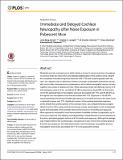Immediate and Delayed Cochlear Neuropathy after Noise Exposure in Pubescent Mice
Author(s)
Jensen, Jane Bjerg; Lysaght, Andrew C.; Liberman, M. Charles; Qvortrup, Klaus; Stankovic, Konstantina M.
DownloadJensen-2015-Immediate and delaye.pdf (5.643Mb)
PUBLISHER_CC
Publisher with Creative Commons License
Creative Commons Attribution
Terms of use
Metadata
Show full item recordAbstract
Moderate acoustic overexposure in adult rodents is known to cause acute loss of synapses on sensory inner hair cells (IHCs) and delayed degeneration of the auditory nerve, despite the completely reversible temporary threshold shift (TTS) and morphologically intact hair cells. Our objective was to determine whether a cochlear synaptopathy followed by neuropathy occurs after noise exposure in pubescence, and to define neuropathic versus non-neuropathic noise levels for pubescent mice. While exposing 6 week old CBA/CaJ mice to 8-16 kHz bandpass noise for 2 hrs, we defined 97 dB sound pressure level (SPL) as the threshold for this particular type of neuropathic exposure associated with TTS, and 94 dB SPL as the highest non-neuropathic noise level associated with TTS. Exposure to 100 dB SPL caused permanent threshold shift although exposure of 16 week old mice to the same noise is reported to cause only TTS. Amplitude of wave I of the auditory brainstem response, which reflects the summed activity of the cochlear nerve, was complemented by synaptic ribbon counts in IHCs using confocal microscopy, and by stereological counts of peripheral axons and cell bodies of the cochlear nerve from 24 hours to 16 months post exposure. Mice exposed to neuropathic noise demonstrated immediate cochlear synaptopathy by 24 hours post exposure, and delayed neurodegeneration characterized by axonal retraction at 8 months, and spiral ganglion cell loss at 8-16 months post exposure. Although the damage was initially limited to the cochlear base, it progressed to also involve the cochlear apex by 8 months post exposure. Our data demonstrate a fine line between neuropathic and non-neuropathic noise levels associated with TTS in the pubescent cochlea.
Date issued
2015-05Department
Harvard University--MIT Division of Health Sciences and TechnologyJournal
PLOS ONE
Publisher
Public Library of Science
Citation
Jensen, Jane Bjerg, Andrew C. Lysaght, M. Charles Liberman, Klaus Qvortrup, and Konstantina M. Stankovic. “Immediate and Delayed Cochlear Neuropathy after Noise Exposure in Pubescent Mice.” Edited by Fan-Gang Zeng. PLoS ONE 10, no. 5 (May 8, 2015): e0125160.
Version: Final published version
ISSN
1932-6203